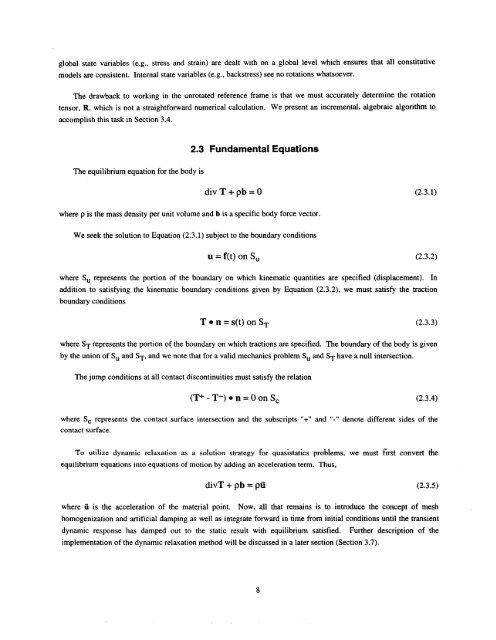II II II II II I - Waste Isolation Pilot Plant - U.S. Department of Energy
II II II II II I - Waste Isolation Pilot Plant - U.S. Department of Energy
II II II II II I - Waste Isolation Pilot Plant - U.S. Department of Energy
- No tags were found...
Create successful ePaper yourself
Turn your PDF publications into a flip-book with our unique Google optimized e-Paper software.
global state variables<br />
models are consistent.<br />
(e.g., stress and strain) are dealt with on a global level which ensures that all constitutive<br />
Internal state variables (e.g., backstress) see no rotations whatsoever.<br />
The drawback to work]ng in the unrotated reference frame is that we must accurately determine the rotation<br />
tensor, R, which is not a straightforward numerical calculation. We present an incremental, algebraic algorithm to<br />
accomplish this task in Section 3.4.<br />
2.3 Fundamental Equations<br />
The equilibrium equation for the body is<br />
div T+pb=O<br />
(2.3.1)<br />
where p is the mass density<br />
per unit volume and b is a specific body force vector.<br />
We seek the solution to Equation (2.3.1) subject to the boundary conditions<br />
u = f(t) on Su (2.3.2)<br />
where Su represents the portion <strong>of</strong> the boundary on which kinematic quantities are specified (displacement). In<br />
addition to satisfying the kinematic boundary conditions given by Equation (2.3.2), we must satisfy the traction<br />
boundary conditions<br />
Ton=s(t)on S~ (2.3.3)<br />
where ST represents the portion <strong>of</strong> the boundary on which tractions are specified. The boundary <strong>of</strong> the body is given<br />
by the union <strong>of</strong> Su and ST, and we note that for a valid mechanics problem Su and ST have a null intersection.<br />
The jump conditions at all contact discontinuities must satis& the relation<br />
(T+- T-). n= Oon Sc (2.3.4)<br />
where Sc represents the contact surface intersection and the subscripts “+” and “-” denote different sides <strong>of</strong> the<br />
contact<br />
surface.<br />
To utilize dynamic relaxation as a solution strategy for quasktatics problems,<br />
equilibrium equations into equations <strong>of</strong> motion by adding an acceleration term. Thus,<br />
divT + pb = pu<br />
we must first convert the<br />
(2.3.5)<br />
where u is the acceleration <strong>of</strong> the material point. Now, all that remains is to introduce the concept <strong>of</strong> mesh<br />
homogenization and artificial darnping as well as integrate forward in time horn initial conditions until the transient<br />
dynamic response has damped out to the static result with equilibrium satisfied. Further description <strong>of</strong> the<br />
implementation <strong>of</strong> the dynamic relaxation method will be discussed in a later section (Section 3.7).<br />
8
















